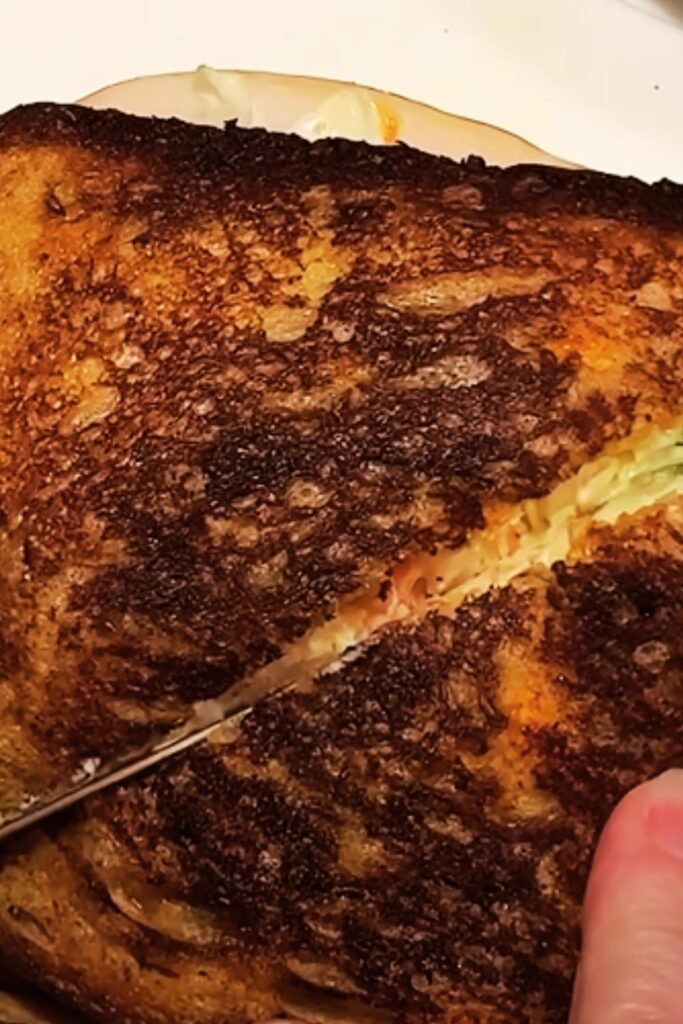Have you ever bitten into a sandwich so perfect that it makes you close your eyes and savor every mouthful? That’s exactly what happens when I sink my teeth into a well-made Rachel sandwich. While its cousin, the Reuben, often steals the spotlight, I’m here to tell you why the Rachel deserves just as much—if not more—recognition in the sandwich hall of fame.
What is a Rachel Sandwich?
A Rachel sandwich is a delightful variation of the classic Reuben. While both share similar DNA, the Rachel replaces corned beef with turkey (or sometimes pastrami) and traditional sauerkraut with coleslaw, creating a lighter, slightly sweeter flavor profile that many find irresistible.
The first time I tried a Rachel sandwich was at a small deli in downtown Chicago. I was a Reuben devotee, skeptical that anything could compete with my beloved sandwich. One bite of the Rachel changed everything. The way the melted Swiss cheese complemented the turkey, how the coleslaw added just the right amount of crunch and tang—it was a revelation.
The History Behind the Name
I’ve always been fascinated by food etymology, especially when it comes to named sandwiches. While the origins of the “Rachel” name aren’t definitively documented, there are several theories worth exploring:
- The most common explanation is that it was named as a feminine counterpart to the Reuben, playing on the lighter nature of turkey versus corned beef—essentially a “ladylike” version of the robust Reuben.
- Others suggest it was named after a specific person named Rachel who either created or popularized this variation.
- Some food historians believe the name emerged naturally in delis across America as customers requested modifications to the classic Reuben.
Whatever the true origin, I find it fitting that this sandwich—with its brighter, fresher flavor profile—has a distinct identity rather than simply being called a “turkey Reuben.”
Essential Ingredients
What makes a Rachel sandwich truly special is the quality and harmony of its ingredients. Let’s break down each component:
- Bread: Rye bread is traditional and, in my opinion, non-negotiable. The earthy, slightly sour notes of rye perfectly complement the other flavors.
- Protein: Turkey is the standard, though pastrami is sometimes used. I prefer freshly roasted turkey breast for the best flavor and texture.
- Cheese: Swiss cheese is traditional. It needs to be generously applied and properly melted.
- Coleslaw: This is what distinguishes a Rachel from a turkey Reuben (which would use sauerkraut). The creamy, slightly sweet nature of coleslaw brings a wonderful contrast.
- Russian Dressing: Tangy, creamy, and slightly sweet, this sauce ties everything together.
- Butter: For grilling the bread to golden perfection.

The Perfect Rachel Sandwich Recipe
Ingredients:
For the Russian Dressing:
- ½ cup mayonnaise
- 2 tablespoons ketchup
- 1 tablespoon sweet pickle relish
- 1 teaspoon Worcestershire sauce
- 1 teaspoon fresh lemon juice
- ½ teaspoon horseradish
- Salt and freshly ground black pepper to taste
For the Coleslaw:
- 2 cups finely shredded green cabbage
- ½ cup shredded carrot
- 2 tablespoons mayonnaise
- 1 tablespoon apple cider vinegar
- 1 teaspoon sugar
- Salt and freshly ground black pepper to taste
For the Sandwich:
- 8 slices of rye bread
- 1 pound thinly sliced roasted turkey breast
- 8 slices Swiss cheese
- 4 tablespoons butter, softened
Equipment:
| Equipment | Purpose | Notes |
|---|---|---|
| Large skillet or griddle | For grilling the sandwich | Cast iron works best for even heat distribution |
| Spatula | For flipping the sandwich | A wide, sturdy spatula prevents the sandwich from falling apart |
| Mixing bowls | For preparing dressing and coleslaw | Various sizes needed |
| Chef’s knife | For slicing ingredients | Keep it sharp for clean cuts through the finished sandwich |
| Measuring cups and spoons | For accurate measurements | Ensures consistency in dressings |
| Grater | For shredding cabbage and carrots (if not pre-shredded) | A box grater or food processor works well |
| Weight or press | Optional, for compressing sandwich while cooking | A second smaller pan or a sandwich press |
Step-by-Step Instructions:
- Prepare the Russian Dressing:
- In a small bowl, combine all dressing ingredients.
- Whisk until smooth and well-blended.
- Refrigerate for at least 30 minutes to allow flavors to meld.
- Make the Coleslaw:
- In a medium bowl, combine cabbage and carrots.
- In a separate small bowl, whisk together mayonnaise, vinegar, sugar, salt, and pepper.
- Pour dressing over cabbage mixture and toss to coat.
- Refrigerate for at least 30 minutes to let flavors develop.
- Assemble the Sandwiches:
- Lay out 8 slices of rye bread on a clean work surface.
- Spread Russian dressing generously on one side of each bread slice.
- On 4 of the slices, layer in this order: 1 slice Swiss cheese, ¼ of the turkey, a generous portion of coleslaw (drained slightly if very wet), another slice of Swiss cheese.
- Top with the remaining bread slices, dressing side down.
- Spread the outer sides of each sandwich with softened butter.
- Cook the Sandwiches:
- Heat a large skillet or griddle over medium heat.
- Place sandwiches in the skillet (work in batches if needed).
- Cook for 3-4 minutes on each side, until bread is golden brown and cheese is melted.
- Press down gently with a spatula while cooking to help compress the sandwich.
- If needed, cover the skillet briefly to ensure cheese melts completely.
- Serve:
- Remove from heat and let rest for 1 minute.
- Cut diagonally and serve immediately.

Tips for Sandwich Perfection
Over the years, I’ve picked up several tricks that elevate a good Rachel sandwich to a truly great one:
Bread Selection and Preparation
The foundation of any great sandwich is the bread. For a Rachel:
- Choose quality rye bread: Seek out bakery-fresh rye with visible caraway seeds for authentic flavor.
- Thickness matters: Slices should be medium thickness—too thin and they’ll fall apart, too thick and the proportions will be off.
- Pre-toast option: For extra crispiness, lightly toast the bread before assembling.
- Even butter application: Spread butter all the way to the edges for uniform browning.
Meat Considerations
- Temperature: Allow turkey to come to room temperature before assembling for even heating.
- Thickness: Have the turkey sliced medium-thin. Too thick and it overwhelms, too thin and it gets lost.
- Arrangement: Fold or loosely layer the turkey rather than placing flat slices for better texture and heat circulation.
- Quantity: About 3-4 ounces per sandwich is ideal.
Cheese Technique
- Room temperature cheese: Take the Swiss out of the refrigerator 20 minutes before using.
- Multiple thin slices: Instead of one thick slice, use two thinner slices for better melting.
- Placement: Always put cheese on both the top and bottom of the fillings—it acts as “glue” to hold everything together.
Coleslaw Secrets
- Drain properly: Excess moisture is the enemy of a crisp sandwich. Let the coleslaw drain in a colander for a few minutes before adding to the sandwich.
- Fresh is best: Make the coleslaw no more than a few hours before assembling sandwiches.
- Temperature: Room temperature coleslaw integrates better with the hot elements.
Russian Dressing Enhancement
- Make ahead: Prepare the dressing at least a day in advance for the best flavor development.
- Consistency: It should be thick enough to stay put on the bread but not so thick it doesn’t integrate with the other ingredients.
- Application technique: Spread to the edges but keep a ½-inch border to prevent oozing.
Cooking Methodology
- Proper heat: Medium-low is key—too hot and the bread burns before the inside warms, too cool and everything gets soggy.
- Patience: Don’t rush the process. A properly cooked Rachel takes about 3-4 minutes per side.
- The press technique: Gently press down with a spatula during cooking, but don’t smash it flat.
- Rest period: Let the sandwich rest for 60 seconds after cooking to allow the melted cheese to set slightly.
Nutritional Information
For those who are mindful of what they eat, here’s a breakdown of what to expect from a standard Rachel sandwich:
| Nutrient | Amount | % Daily Value* |
|---|---|---|
| Calories | 650-750 | 33-38% |
| Total Fat | 35-45g | 45-58% |
| Saturated Fat | 15-20g | 75-100% |
| Cholesterol | 100-120mg | 33-40% |
| Sodium | 1800-2200mg | 78-96% |
| Total Carbohydrate | 45-55g | 16-20% |
| Dietary Fiber | 4-6g | 14-21% |
| Sugar | 6-8g | – |
| Protein | 35-40g | 70-80% |
*Based on a 2,000 calorie diet
Note: This is an approximate analysis. Values may vary depending on specific ingredients and portion sizes.
Variations Worth Exploring
While I’m a purist at heart, I’ve experimented with several delicious variations over the years:
The California Rachel
- Add avocado slices
- Replace Russian dressing with herb mayonnaise
- Add sprouts for extra crunch
- Use multigrain bread instead of rye
The Spicy Rachel
- Add thin slices of jalapeño
- Mix sriracha into the Russian dressing
- Use pepper jack instead of Swiss cheese
- Add a dash of hot sauce to the coleslaw
The Mediterranean Rachel
- Use Greek yogurt in the coleslaw instead of mayonnaise
- Add thin cucumber slices
- Mix in Kalamata olives and feta to the coleslaw
- Season with oregano and lemon zest
The Lighter Rachel
- Use low-fat mayo in both the dressing and coleslaw
- Opt for turkey breast only (no dark meat)
- Use reduced-fat Swiss cheese
- Choose a whole grain rye bread

Serving Suggestions
A Rachel sandwich is satisfying on its own, but pairing it with the right sides elevates the entire meal experience:
Classic Pairings
- Dill pickle spears: The briny crunch beautifully complements the sandwich.
- Kettle chips: The hearty crunch works wonderfully with the sandwich’s complex textures.
- Coleslaw: Extra coleslaw on the side reinforces the flavors.
- Potato salad: A German-style potato salad with vinegar dressing pairs exceptionally well.
- Green salad: A simple green salad with vinaigrette offers a refreshing contrast.
Beverage Pairings
- Unsweetened iced tea: The tannic quality cuts through the richness.
- Sparkling water with lemon: The effervescence cleanses the palate.
- Ginger ale: The subtle sweetness and spice complement the Russian dressing.
- Black coffee: The bitterness balances the sandwich’s richness.
- Lemonade: A tart homemade lemonade works surprisingly well.
Storage and Reheating
In my experience, a Rachel sandwich is always best fresh off the griddle. However, life happens, and sometimes you need to save half for later. Here’s how to do it right:
Short-term Storage
If you need to store a Rachel for a few hours:
- Wrap tightly in wax paper, then aluminum foil.
- Store at room temperature up to 2 hours.
- Do not refrigerate if planning to eat same day—the bread will get soggy.
Next-day Storage
If you must save it overnight:
- Deconstruct if possible—store bread, cheese, meat, and coleslaw separately.
- If already assembled, wrap tightly in wax paper, then place in an airtight container.
- Refrigerate promptly.
Reheating Methods
| Method | Pros | Cons | Instructions |
|---|---|---|---|
| Skillet | Best texture restoration, crispy exterior | Takes attention and time | Heat skillet to medium-low, add 1 tsp butter, cook 2 mins per side covered |
| Toaster oven | Good overall results, minimal effort | Can dry out the sandwich | Wrap loosely in foil, heat at 325°F for 5-7 minutes |
| Regular oven | Even heating | Takes time to preheat, can dry out | Wrap in foil, bake at 325°F for 10 minutes |
| Microwave | Quick | Results in soggy bread, changes texture | Last resort only! 30 seconds at 50% power |
| Air fryer | Quick with good texture | Can cause fillings to shift | 350°F for 2-3 minutes |
Why I Choose Turkey Over Pastrami
While some Rachel recipes call for pastrami instead of turkey, I’ve always been partial to turkey for several reasons:
- Lighter profile: Turkey allows the other flavors to shine without overwhelming them.
- Texture contrast: The tender turkey creates a different mouthfeel against the crunchy coleslaw.
- Versatility: Turkey takes on the flavors of the Russian dressing beautifully.
- Broad appeal: Even those who find pastrami too strong usually enjoy a turkey-based Rachel.
That said, I encourage you to try both versions and decide which you prefer. Food is personal, and the “right” Rachel is the one you enjoy most!
Common Mistakes to Avoid
Even experienced sandwich makers can fall prey to these Rachel sandwich pitfalls:
- Using too much coleslaw: This leads to a soggy, unwieldy sandwich. Drain properly and use in moderation.
- Skimping on cheese: The Swiss cheese is crucial for both flavor and structural integrity. Don’t be stingy!
- Rushing the cooking process: Low and slow is the way to go for proper cheese melting and bread browning.
- Using mass-produced rye bread: The quality of the bread makes or breaks this sandwich. Seek out good bakery rye.
- Over-applying Russian dressing: It should complement, not drown, the other ingredients.
- Not cutting on the diagonal: This isn’t just about presentation—the diagonal cut creates the perfect bite ratio of ingredients.
- Using pre-packaged coleslaw: The preservatives and excess moisture can ruin the texture and flavor balance.
Q&A Section
Is a Rachel sandwich healthy?
While the Rachel sandwich isn’t low-calorie fare, it offers more nutritional benefits than many fast food options. The turkey provides lean protein, the coleslaw adds vegetables, and rye bread offers more fiber than white bread. To make it healthier, use light mayonnaise in the dressing and coleslaw, reduce the cheese by half, and serve with a side salad instead of chips.
Can I prepare components ahead of time?
Absolutely! Both the Russian dressing and coleslaw actually benefit from being made a day ahead, allowing flavors to develop. The sandwich itself should be assembled and grilled just before eating for optimal texture and taste.
Why is my sandwich soggy?
The most common culprit is excess moisture in the coleslaw. Make sure to drain it thoroughly before adding to the sandwich. Another possibility is that your griddle or pan wasn’t hot enough when you started cooking, giving the bread time to absorb moisture before crisping.
What’s the difference between Russian dressing and Thousand Island?
While similar, Russian dressing is typically spicier and less sweet than Thousand Island. Russian dressing usually contains horseradish and has a more pronounced peppery flavor, while Thousand Island often includes pickle relish and has a sweeter profile. Either will work in a Rachel, but authentic Russian dressing gives the classic flavor.
Can I make a vegetarian Rachel?
Yes! Replace the turkey with thinly sliced tempeh or a plant-based turkey alternative. The rest of the components are already vegetarian-friendly. For a vegan version, use plant-based mayonnaise and cheese alternatives.
What kind of rye bread is best?
Traditional Jewish-style rye with caraway seeds provides the most authentic flavor. However, marble rye or pumpernickel can also work beautifully. The key is finding a fresh loaf with good structure that can stand up to grilling without falling apart.
Can I make mini Rachels for a party?
Absolutely! Use small rye cocktail bread to create bite-sized Rachel sandwiches. These make excellent appetizers. To prevent sogginess, assemble them just before serving or keep the components separate and let guests build their own.
Conclusion
The Rachel sandwich represents everything I love about great food: thoughtful balance of flavors, contrasting textures, and the elevation of simple ingredients into something greater than the sum of its parts. Whether you’re a sandwich aficionado or simply someone looking for a satisfying meal, I encourage you to give this underappreciated classic a try.
What sets the Rachel apart from other sandwiches is its perfect balance—tangy, creamy, savory, and slightly sweet, all working in harmony. The way the warm, melted Swiss cheese embraces the turkey, the crunch of properly grilled rye bread, and the cool, crisp coleslaw creating textural contrast in every bite—these elements create sandwich perfection.
I hope this guide inspires you to create your own perfect Rachel sandwich. Remember, the key to sandwich mastery lies not just in quality ingredients, but in the care and attention to detail during preparation. Take your time, follow the techniques outlined above, and you’ll be rewarded with one of the greatest sandwiches known to humankind.
Now if you’ll excuse me, I have a sudden craving that only a freshly grilled Rachel sandwich can satisfy!